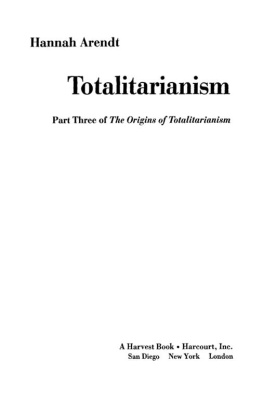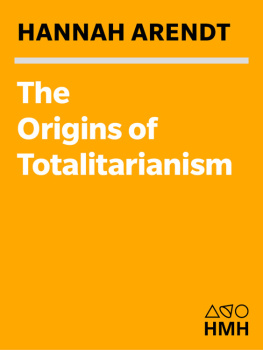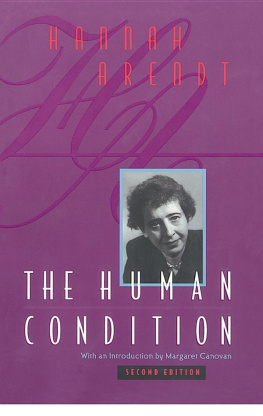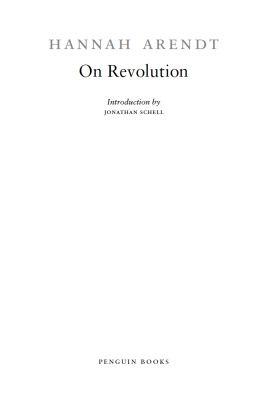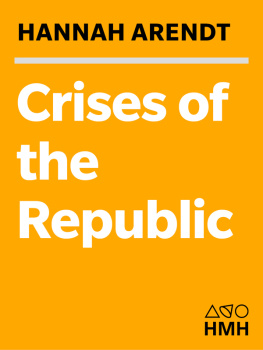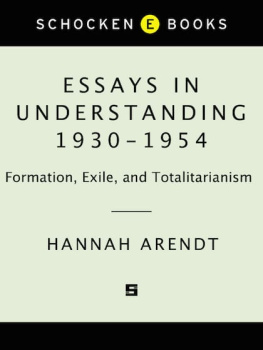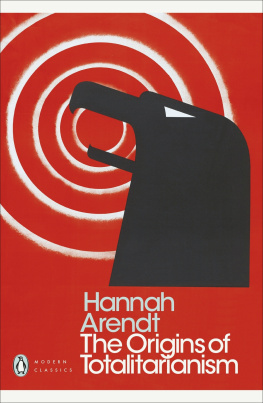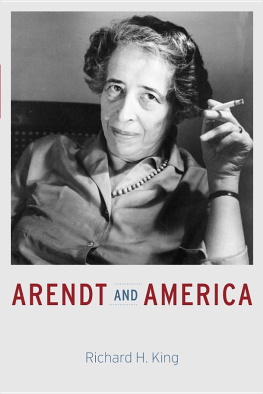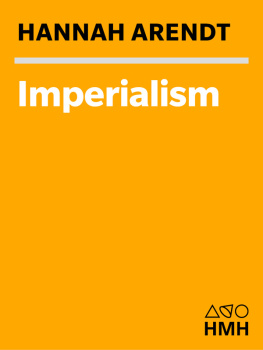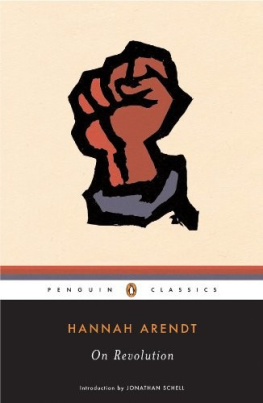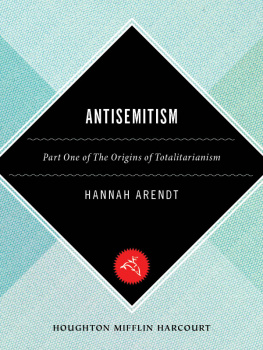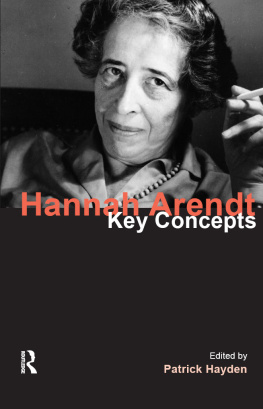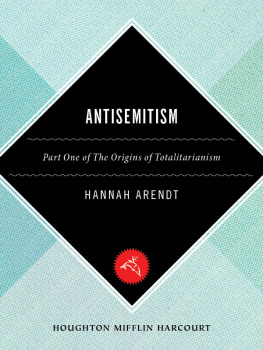A Harvest Book Harcourt, Inc.
San Diego New York London
Copyright 1968, 1966 by Hannah Arendt
Copyright renewed 1951, 1948 by Hannah Arendt
Copyright renewed 1994 by Lotte Kohler
Copyright renewed 1979 by Mary McCarthy West
Copyright renewed 1976 by Hannah Arendt
All rights reserved. No part of this publication may be reproduced or transmitted
in any form or by any means, electronic or mechanical, including photocopy,
recording, or any information storage and retrieval system, without
permission in writing from the publisher.
Requests for permission to make copies of any part of the work
should be mailed to Permissions Department, Harcourt, Inc,
6277 Sea Harbor Drive, Orlando, Florida 32887-6777.
Library of Congress Cataloging-in-Publication Data
Arendt, Hannah
The origins of totalitarianism
"A Harvest book."
Includes bibliographies and indexes
Contents pt 1. Antisemitismpt 2. Imperialism
pt 3. Totalitarianism.
1. Totalitarianism. 2. Imperialism. 3. Antisemitism
I Title
JC481 A62 1985 321 9 84-22579
ISBN 0-15-607810-4 (pbk v. 1)
ISBN 0-15-644200-0 (pbk. v 2)
ISBN 0-15-690650-3 (pbk.: v 3)
Printed in the United States of America
Z Y X W
Introduction
I
T HE ORIGINAL manuscript of The Origins of Totalitarianism was finished in autumn 1949, more than four years after the defeat of Hitler Germany, less than four years before Stalin's death. The first edition of the book appeared in 1951. In retrospect, the years I spent writing it, from 1945 onwards, appear like the first period of relative calm after decades of turmoil, confusion, and plain horrorthe revolutions after the First World War, the rise of totalitarian movements and the undermining of parliamentary government, followed by all sorts of new tyrannies, Fascist and semi-Fascist, one-party and military dictatorships, finally the seemingly firm establishment of totalitarian governments resting on mass support: in Russia in 1929, the year of what now is often called the "second revolution," and in Germany in 1933.
With the defeat of Nazi Germany, part of the story had come to an end. This seemed the first appropriate moment to look upon contemporary events with the backward-directed glance of the historian and the analytical zeal of the political scientist, the first chance to try to tell and to understand what had happened, not yet sine ira et studio, still in grief and sorrow and, hence, with a tendency to lament, but no longer in speechless outrage and impotent horror. It was, at any rate, the first possible moment to articulate and to elaborate the questions with which my generation had been forced to live for the better part of its adult life: What happened? Why did it happen? How could it have happened? For out of the German defeat, which left behind a country in ruins and a nation that felt it had arrived at "point zero" of its history, mountains of paper had emerged virtually intact, a super-abundance of documentary material on every aspect of the twelve years that Hitler's Tausendjahriges Reich had managed to last. The first generous selections from this embarras de richesses, which even today are by no means adequately published and investigated, began to appear in connection with the Nuremberg Trial of the Major War Criminals in 1946, in the twelve volumes of Nazi Conspiracy and Aggression.
Much more documentary and other material, however, bearing on the Nazi regime, had become available in libraries and archives when the second (paperback) edition appeared in 1958. What I then learned was interesting enough, but it hardly required substantial changes in either the analysis or the argument of my original presentation. Numerous additions and replacements of quotations in the footnotes seemed advisable, and the text was considerably enlarged. But these changes were all of a technical nature. In 1949, the Nuremberg documents were known only in part and in English translations, and a great number of books, pamphlets, and magazines published in Germany between 1933 and 1945 had not been available. Also, in a number of additions I took into account some of the more important events after Stalin's deaththe successor crisis and Khrushchev's speech at the Twentieth Party Congressas well as new information on the Stalin regime from recent publications. Moreover, there were certain insights of a strictly theoretical nature, closely connected with my analysis of the elements of total domination, which I did not possess when I finished the original manuscript that ended with rather inconclusive "Concluding Remarks." The last chapter of this edition, "Ideology and Terror," replaced these "Remarks," which, to the extent that they still seemed valid, were shifted to other chapters. To the second edition, I had added an Epilogue where I discussed briefly the introduction of the Russian system into the satellite countries and the Hungarian Revolution. This discussion, written much later, was different in tone since it dealt with contemporary events and has become obsolete in many details. I have now eliminated it, and this is the only substantial change of this edition as compared with the second (paperback) edition.
Obviously, the end of the war did not spell the end of totalitarian government in Russia. On the contrary, it was followed by the Bolshevization of Eastern Europe, that is, the spread of totalitarian government, and peace offered no more than a significant turning point from which to analyze the similarities and differences in methods and institutions of the two totalitarian regimes. Not the end of the war but Stalin's death eight years later was decisive. In retrospect, it seems that this death was not merely followed by a successor crisis and a temporary "thaw" until a new leader had asserted himself, but by an authentic, though never unequivocal, process of detotalitarization. Hence, from the viewpoint of events, there was no reason to bring this part of my story up to date now; and as far as our knowledge of the period in question is concerned, it has not changed drastically enough to require extensive revisions and additions. In contrast to Germany, where Hitler used his war consciously to develop and, as it were, perfect totalitarian government, the war period in Russia was a time of temporary suspense of total domination. For my purposes, the years from 1929 to 1941 and then again from 1945 down to 1953 are of central interest, and for these periods our sources are as scarce and of the same nature as they were in 1958 or even in 1949. Nothing has happened, or is likely to happen in the future, to present us with the same unequivocal end of the story or the same horribly neat and irrefutable evidence to document it as was the case for Nazi Germany.
In other words, while it has always been known that official Soviet publications served propaganda purposes and were utterly unreliable, it now appears that reliable source and statistical material probably never existed anywhere.
A much more serious question is whether a study of totalitarianism can afford to ignore what has happened, and is still happening, in China. Here our knowledge is even less secure than it was for Russia in the thirties, partly because the country has succeeded in isolating itself against foreigners after the successful revolution much more radically, and partly because defectors from the higher ranks of the Chinese Communist Party have not yet come to our aidwhich, of course, in itself is significant enough. For seventeen years, the little we knew beyond doubt pointed to very relevant differences: after an initial period of considerable bloodshedthe number of victims during the first years of dictatorship is plausibly estimated at fifteen million, about three percent of the population in 1949 and, in terms of percentage, considerably less than the population losses due to Stalin's "second revolution"and after the disappearance of organized opposition, there was no increase in terror, no massacres of innocent people, no category of "objective enemies," no show trials, though a great deal of public confession and "self-criticism," and no outright crimes. Mao's famous speech in 1957, "On the Correct Handling of Contradictions among the People," usually known under the misleading title "Let a Hundred Flowers Bloom," was certainly no plea for freedom, but it did recognize non-antagonistic contradictions between classes and, more importantly, between the people and the government even under a Communist dictatorship. The way to deal with opponents was "rectification of thought," an elaborate procedure of constant molding and remolding of the minds, to which more or less the whole population seemed subject. We never knew very well how this worked in everyday life, who was exempt from itthat is, who did the "remolding"and we had no inkling of the results of the "brainwashing," whether it was lasting and actually produced personality changes. If one were to trust the present announcements of the Chinese leadership, all it produced was hypocrisy on a gigantic scale, the "breeding grounds for counter-revolution." If this was terror, as it most certainly was, it was terror of a different kind, and whatever its results, it did not decimate the population. It clearly recognized national interest, it permitted the country to develop peacefully, to use the competence of the descendants of the formerly ruling classes, and to uphold academic and professional standards. In brief, it was obvious that Mao Tse-tung's "thought" did not run along the lines laid down by Stalin (or Hitler, for that matter), that he was not a killer by instinct, and that nationalist sentiment, so prominent in all revolutionary upheavals in formerly colonial countries, was strong enough to impose limits upon total domination. All this seemed to contradict certain fears expressed in this book (p. 9).
Next page
